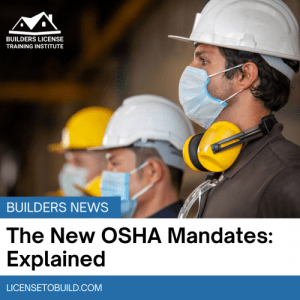The New OSHA Mandates: Explained
Published on September 16, 2021 by Nate Bortz

On September 9th, President Biden announced a new "Path Out of the Pandemic" plan, which aims to reduce the spread of COVID-19 — mainly by increasing vaccination mandates across the business sector.
Here's a summary of what the new plan means for contractors and how you can prepare for what's ahead.
OSHA's Emergency Temporary Standard Update Summary
- Under the President's new plan, The U.S. Department of Labor's Occupational Safety and Health Administration (OSHA) is developing a new emergency temporary standard (ETS) that requires all businesses with more than 100 employees to do the following:
- Require vaccination
- Require weekly COVID-19 testing for unvaccinated workers every week — and only allow employees to work if the test is negative
Other requirements included in this the new ETS include:
- Enforcing the executive order that the President signed earlier this month that requires all federal executive branch workers to be vaccinated — this also includes contractors that work with the federal government.
- Employers with more than 100 employees must provide paid time off for the time it takes for workers to get vaccinated or recover if they are under the weather post-vaccination.
Reasoning for the new ETS
During his address announcing the new pandemic plan, the President justified these new mandates by calling the country's current situation "the pandemic of the unvaccinated." And that despite the U.S. making vaccinations "free, safe, and convenient," there are still 80 million Americans who haven't gotten at least one dose of the vaccine.
In a recent CDC report that examined 13 U.S. Jurisdictions between April 4 – July 17, 2021, the CDC discovered that unvaccinated people are 10 times more likely to be hospitalized by COVID-19, and 11 times more likely to die of COVID-19.
Despite the reasoning, there are some doubts that The Department of Labor and OSHA can enforce sweeping vaccination mandates.
Mandate Legality
We've already covered that, yes, private employers can mandate vaccinations (with exceptions). But what about the government?
In a nutshell: state and local governments can mandate vaccines. Most states, for example, have vaccination mandates for children entering a childcare facility or school.
As for the federal government, it's generally accepted that a national, federal vaccine mandate is not possible. For more details, see NFIB v. Sebelius (2012), where the Supreme Court ruled "if someone does not want to take a particular action, the federal government's ability to require them to take that action is limited."
This is why some organizations are questioning OSHA's ability to enforce this mandate.
OSHA'S Role
OSHA is in charge of formulating and enforcing these new ETS vaccine rulings, but that might be a challenge because the agency "is significantly understaffed, and its emergency rulemaking mechanism has a mixed track record," according to Reuters.
Right now, enforcing the new rules means pitting over 100,000 private-sector companies against OSHA's 800 safety and compliance inspectors. And as for the ETS rules themselves, companies and organizations are still asking for more details.
Reuters reported that on Monday, The Consumer Brands Association — which represents consumer packaged goods companies like Coca-Cola Co and Procter & Gamble Co. — wrote to the Biden administration seeking "immediate clarity" on how workers would prove they are documented and whether they need to be fully vaccinated to work.
Then, once OSHA releases the full details behind this ETS ruling, they will likely be scrutinized by lawmakers and relevant organizations. Brian Turmail, vice president of public affairs and strategic initiatives of the Associated General Contractors of America, said "we will review the new OSHA ETS when it is released to ensure that it will be effective in improving the health and safety of the construction workforce and that it does not impose unreasonable new burdens on employers."
What to Do Now
While the detailed requirements of the OSHA and state ETS's will not be immediately available, here's a helpful list courtesy of The National Law Review that employers should use to plan how they will meet the ETS requirements once compliance becomes mandatory.
Considerations employers should address:
- Whether the ETS applies to your workplace
- How to deal with remote workers
- How to coordinate with on-site contractors about compliance, particularly those with fewer than 100 employees
- How to identify vaccinated and unvaccinated employees and how to update that information
- How employees should report the results of testing
- Whether to require proof of vaccination and if so, what proof to require
- Whether to sponsor on-site vaccination clinics
- Whether to sponsor on-site testing
- Whether to supply test kits and how to obtain them; and if not, how to instruct employees in obtaining test kits
- Whether to pay for test kits and if so, how to do so
- How to provide paid time off for vaccination and recovery
- How to deal with employees who refuse both vaccination and testing
- How to keep records supporting compliance, keeping in mind that the standard on access to employee exposure and medical records, 29 C.F.R. § 1910.1020, may apply to some records.
In addition, employers should continue to consider OSHA's guidance (updated August 13, 2021) on other aspects of protecting workers from COVID-19.
Conclusion
No matter what's included in OSHA's new ETS, keep an eye on our blog in the future to get a simple overview that you can easily understand. And remember to check out our new OSHA-Authorized Safety courses to ensure you stay compliant in every other area.
